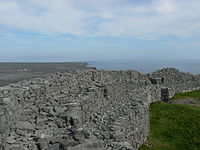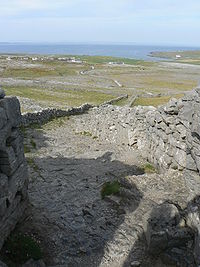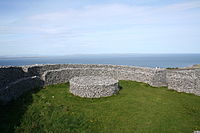- Dún Aonghasa
-
Dún Aonghasa is the most famous of several prehistoric forts on the Aran Islands, of County Galway, Ireland. It is located on Inishmore at the edge of an approximately 100 metre high cliff.
A popular tourist attraction, Dún Aonghasa is an important archaeological site that also offers a spectacular view. It is not known when Dún Aonghasa was built, though it is now thought to date from the Iron Age.[1] T. F. O'Rahilly surmised that it was built in the 2nd century BC by the Builg following the Laginian conquest of Connacht.[2]
Dún Aonghasa has been called "the most magnificent barbaric monument in Europe." [3] The Proto-Celtic name, meaning "Fort of Aonghas", refers to the pre-Christian god of the same name described in Irish mythology, or the mythical king, Aonghus mac Úmhór.
Contents
Form and function
The fort consists of a series of four concentric walls of dry stone construction, built on a high cliff some one hundred metres above the sea.[4] Surviving stonework is four metres wide at some points. The original shape was presumably oval or D-shaped but parts of the cliff and fort have since collapsed into the sea. Outside the third ring of walls lies a defensive system of stone slabs, known as a cheval de frise, planted in an upright position in the ground and still largely well-preserved. These ruins also feature a huge rectangular stone slab, the function of which is unknown. Impressively large among prehistoric ruins, the outermost wall of Dún Aonghasa encloses an area of approximately 6 hectares (14 acres). Although clearly defensible, the particular location of Dún Aonghusa suggests that its primary purpose was religious and ceremonial rather than military.[citation needed] It may have been used for seasonal rites by the druids, perhaps involving the bonfires that could be seen from the mainland of Ireland.[5] The location also provides a view of as much as 120 km (75 mi) of coastline,[6] which may have allowed for control over a coastal trading highway.
Visitor notes
 A view over the karst landscape on Inishmore, from Dún Aonghasa
A view over the karst landscape on Inishmore, from Dún Aonghasa
The walls of Dún Aonghasa have been rebuilt to a height of 6m and have wall walks, chambers, and flights of stairs. The restoration is easily distinguished from the original construction by the use of mortar. Exploring Dún Aonghasa requires a bit of climbing, and there is no rail at the edge of the cliff, so it may not be a good place to visit with small children or people with mobility problems. There is a small museum illustrating the history of the fort and its possible functions. Also in the vicinity is a Neolithic tomb and a small heritage park featuring examples of a traditional thatched cottage and an illegal poteen distillery.[5]
Neighboring sites
Dún Dúchatair (Black Fort), Dún Eoghanachta (Fort of the Eóganachta), and Dún Eochla are similar prehistoric sites on Inishmore. Dún Chonchúir (Fort of Conchobar) is located on nearby Inishmaan.
References
- ^ New Oxford History of Ireland
- ^ O'Rahilly, T. F. (1984). Early Irish History and Mythology. Dublin: Dublin Institute for Advanced Studies. ISBN 9780901282293.
- ^ George Petrie
- ^ Robert Gibbings - Lovely is the Lee
- ^ a b Prehistoric Forts
- ^ Bronze Age Bastion
External links
Categories:- Forts in Ireland
- Archaeological sites in County Galway
- Aran Islands
- Bronze Age Britain
- National Monuments in County Galway
Wikimedia Foundation. 2010.




